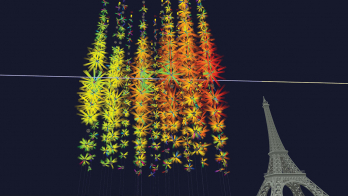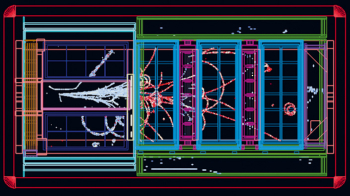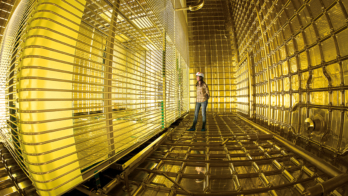A new way of making neutrino beams has caught the attention of physicists worldwide.
Almost every day, fresh results steadily fuel the progress of science. Less frequently, major breakthroughs in experimental techniques revolutionize the way in which this research is done. Examples of such breakthroughs in particle physics include the development of accelerators in the 1950s, and of colliding rings in the late 1960s, finally culminating with CERN’s proton-antiproton collider, using beam-cooling techniques and opening up a new energy regime.
Although there is still a long research and development road to be negotiated, the first major breakthrough in particle physics experimental techniques for the 21st century looks to be the advent of a new type of machine – the muon storage ring – and using it to provide neutrino beams.
Making accelerators with muons seems crazy at first. Machine builders so far have had the wisdom to store and accelerate particles that are abundant – like the protons and electrons naturally found in matter – or, if not abundant, that at least have the good taste to be stable, like positrons and antiprotons.
It takes at least 30 min to fill CERN’s LEP collider and accelerate its beams of electrons and positrons. How could one do such a thing with unstable muons, with their combined inconveniences of being rare and having a lifetime of a mere 2.2 ms?
Progress in accelerator techniques has made this challenge at least conceivable, to the extent that there has been discussion of muon collider rings as a serious future option in the US and at CERN.
When, following the inspiration of the US muon collider collaboration, European physicists started looking at this new route, the obstacles appeared overwhelming, with many new problems to solve simultaneously.
A breakthrough came with the realization that muon decay could be turned into an advantage – muon storage rings would be an abundant source of neutrinos. Coming at the same time as the new awareness of neutrino oscillations, this step forward met with a thunderclap of enthusiasm.
The muon storage ring as neutrino source, nicknamed “neutrino factory”, requires a much lower density of particles and should thus be easier to build than a muon collider. The decay of muons into electrons provides the only known source of high-energy electron-type neutrinos – a unique and powerful new physics tool.
This led the prospective study group mandated by the European Committee for Future Accelerators (ECFA) to propose a three-step approach to muon storage rings, the first being the construction of a neutrino factory (Autin, Blondel and Ellis 1999). This has led to a series of international workshops – Lyon in July 1999 and Monterey, California, in May 2000. Neutrino-factory research and development is now a well recognized and supported project at CERN and further afield, with ECFA-supported study groups investigating the very rich physics opportunities.
Beams from rings
The key requirement is a very intense proton accelerator, delivering several megawatts of beam power. These protons will be used to create pions, which will be magnetically collected. Designing a target to withstand so much power more than once is beyond what has been achieved so far and will require either a liquid jet target or a very large rotating wheel to dissipate the heat.
Pion collection is optimized for rather low momentum – about 300 MeV/c. These pions rapidly decay into muons of similar momentum. At this point the “beam” is about 1 m across and the haphazard momentum spread 100% – more like a big, hot potato than a beam.
The design challenge is to shrink the momentum spread to 5% and the beam size to a few centimetres within a few microseconds to shape the muons into an acceptable beam.
This requires two crucial elements. The first, “phase rotation” (“monochromatization”), uses variable longitudinal electric fields of a few million volts per metre to slow down the fastest particles and accelerate the slow ones. This needs either high-gradient, low-frequency radiofrequency cavities or an induction linac, with considerably improved performance compared with what has been achieved so far.
The second crucial beam element is cooling. Beam cooling was a key feature of CERN’s antiproton project, converting the largest possible number of rare particles produced from a target into a smooth beam. While antiprotons are stable and can be stored almost indefinitely, muons need fast action. However, as muons choose not to interact strongly with nuclear matter, one can use cooling via ionization energy loss, reducing the momentum in three dimensions. Followed up by reacceleration in the beam direction via a longitudinal electric field, the net result will be a decrease of transverse momentum. Simulations are promising, but this technique has yet to be demonstrated in practice.
This initial conditioning is followed by a series of fast accelerators to take the muon beam to high energy. If well designed, the system spares enough muons after decays or acceptance losses so that, from the original 1016 protons per second, 1014 high-energy muons per second can be injected into a storage ring, where during a few hundred turns, positively charged muons, for example, will decay into electrons, accompanied by electron-type neutrinos and muon-type antineutrinos.
Storage ring geometry
The intentionally long, straight sections of the storage “ring” generate a large flux of collimated neutrinos, particularly electron-type ones, with properties very different to those of traditional laboratory neutrino beams (which are mainly composed of muon-type neutrinos). The geometry of the storage ring is left to the designer’s imagination. Bow-tie, triangular and trombone ring configurations have been proposed.
Whatever the geometry, very intense neutrino beams would be available right next to the storage ring, opening a new era of neutrino physics. However, what has made everyone really excited is the prospect of firing neutrino beams through the Earth, serving several underground experiments in several continents and providing different neutrino flight paths – “baselines” – for the study of neutrino oscillations.
For a long time the three neutrino types (electron-, muon- and tau-) were considered massless, and thus immutable.
Following indications from solar neutrinos as early as 1975, experiments studying neutrinos produced by the decay of cosmic-ray pions and muons in the atmosphere finally confirmed in 1998 that neutrinos undergo transmutations. The observed signals can only be understood if neutrinos starting out as muon-type in the upper atmosphere change into another type in transit – probably tau neutrinos. This neutrino “oscillation” can only be understood if the particles have a mass.
Although these masses are probably tiny – a fraction of an electron volt – the consequences are considerable. As neutrinos are one of the most common particles in the universe, their total mass could provide a significant fraction of the whole mass of creation. From the particle physicists’ point of view, neutrinos are very interesting. Since they do not feel electromagnetic or strong forces, one hopes they could provide cleaner clues to the origin of mass.
In quantum mechanical language, neutrinos produced in a weak decay or interacting via weak interaction are well defined – the well known electron, muon and tau neutrino “flavours”. However, if they have mass, neutrinos also feel the mysterious “Higgs” force that generates masses, and the neutrino states emerging with well defined masses need not be the same as those with well defined flavours.
The three flavour neutrinos are therefore mixtures of the three mass neutrinos, and a matrix of parameters connects the two triplets. Moreover, as usual in quantum mechanics, this mixing has time-dependent phases, so that any one neutrino flavour turns into another as time passes – as one type of neutrino disappears, another “appears” to take its place. This is what is meant by neutrino oscillations.
Information on these oscillations is still scanty, but atmospheric neutrino experiments tells us that a muon neutrino of 1 GeV probably turns into a tau neutrino after about 500 km. Experiments with electron neutrinos from nuclear reactors show that these particles are reluctant to oscillate on this timescale. The disappearance of solar neutrinos, which set out as electron-type, shows that these particles have a much longer oscillation timescale. However, solar neutrinos are somewhat ambiguous, since neutrinos produced deep in the stellar interior have to travel through the Sun before emerging into the vacuum of space, and one does not know where the oscillation takes place.
New “long baseline” experiments, firing neutrino beams at detectors hundreds of kilometres distant, are setting out to explore these oscillations in more detail. However, these experiments are based on conventional synthetic neutrino beams, composed mainly of muon-type particles, and are expected to validate and sharpen the pattern derived from the combined findings of atmospheric neutrino experiments and reactor neutrino experiments, although surprises cannot be excluded.
Crucial information should come from new reactor and solar neutrino experiments – Kamland, Borexino and SNO – sensitive to the disappearance of electron neutrinos suggested by the solar neutrino experiments.
New neutrino physics
With the neutrino factory, and as new results from solar, reactor and accelerator experiments become available, physicists can plan a much more systematic investigation of neutrino mass differences and mixings. The key is the high-intensity flux of electron neutrinos from a neutrino factory. With this, any appearance of muon neutrinos from oscillation of the electron neutrinos would give an immediately recognizable neutrino interaction signature, producing a muon of opposite sign to that of the original muon beam.
Comparing results using beams of positively and negatively charged muons would contrast the behaviour of electron neutrinos and their antineutrinos. As neutrinos pass through matter, they encounter atomic electrons. The interactions of electron neutrinos and antineutrinos with these electrons are different, and would lead to a matter-induced asymmetry.
Depending on whether the transmutation into muon neutrinos of electron neutrinos and antineutrinos are enhanced or suppressed by matter, one would be able to distinguish between the two mass scenarios shown in the figure.
CP violation with neutrinos
Comparing oscillation rates for electron neutrinos and antineutrinos would open another possibility, which until recently had been almost unthinkable. By comparing the transformations of, say, electron-neutrinos into muon neutrinos with the process in the reverse direction, and with the corresponding rates for antineutrino transformations, physicists could for the first time be able to investigate delicate CP and time symmetry violations for the neutrino sector.
Such effects have been well explored in the quark sector, using the neutral kaon system. CP violation unambiguously differentiates particles and antiparticles, implying that what is called matter and what is called antimatter is not a heads-or-tails call. This is one of the necessary ingredients to explain how a matter-dominated universe evolved from a Big Bang that supposedly produced equal amounts of matter and antimatter.
CP violation is deeply connected to the violation of time reversal symmetry, when a “film” of a particle interaction run backwards would look different.
World machine
Neutrino physicists are very excited at these prospects. However, such experiments would require very long baselines (in excess of 3000 km) and preferably two different baselines to unravel different processes. This leads to a vision of a truly world machine with intercontinental beams.
These new neutrino sources are of world-wide interest and a whole network of detailed working groups has been set up to attack the problems. A crash study at Fermilab will shortly make its recommendations, while a wider study involves other US laboratories.
In Europe, CERN has set up a neutrino factory study group with specialized subgroups looking at specific machine components (proton driver, targets, accumulator rings, etc). Other groups, under the sponsorship of the ECFA, look at physics objectives. These studies involve specialists from many European laboratories.
By the time this year’s Neutrino Factory meeting in Monterey takes place in May, these plans should have progressed significantly and hopefully give insight on how difficult the construction of a neutrino factory will be, on how long it would take to design and build. A similar effort is necessary to understand what detectors could be built to best take advantage of these fascinating beams. This is certainly a line of physics that will take us well into this century!
Further reading
B Autin, A Blondel and J Ellis, Prospective Study of Muon Storage Rings at CERN,CERN 99-02, ECFA 99-197.



